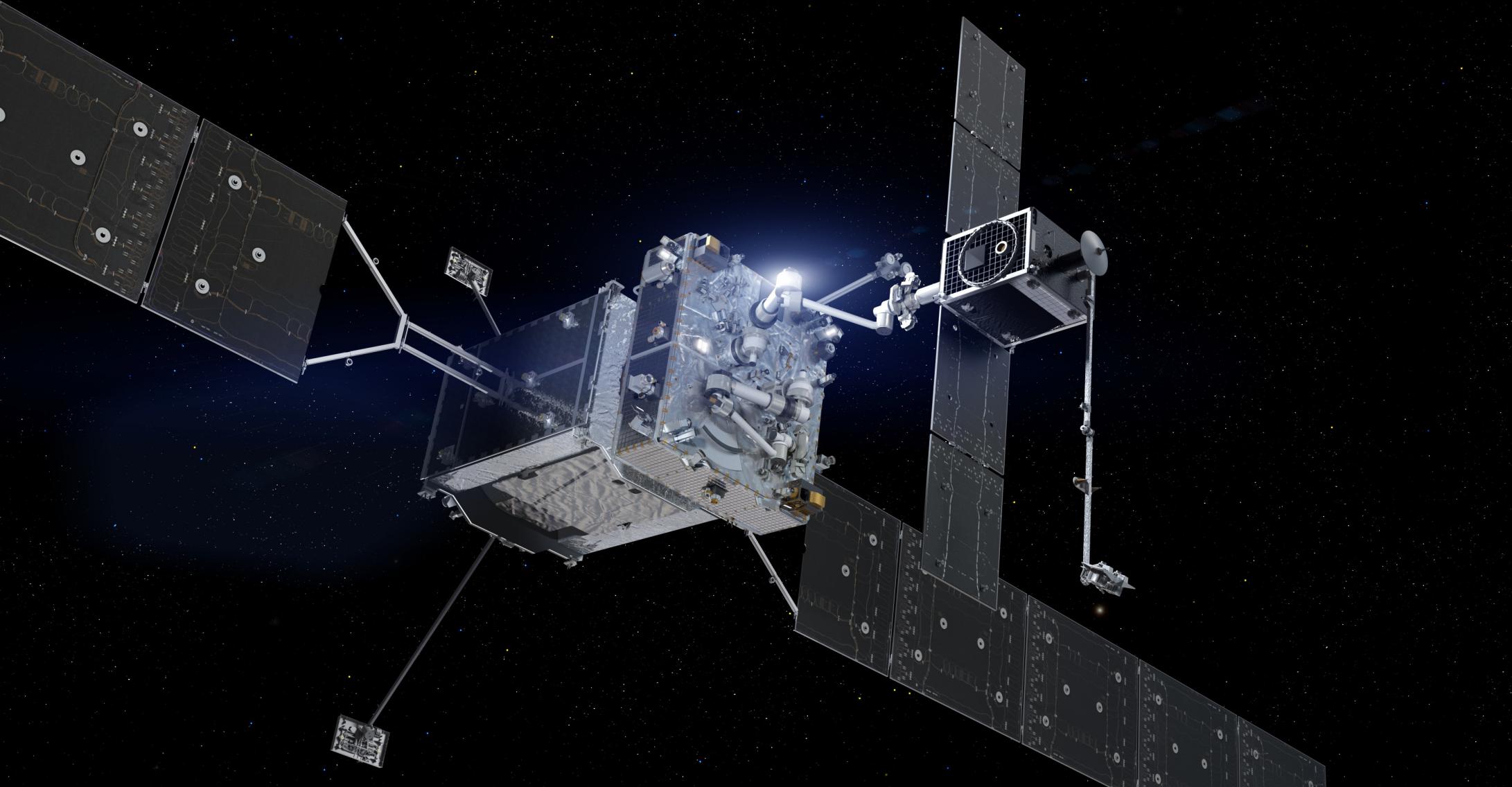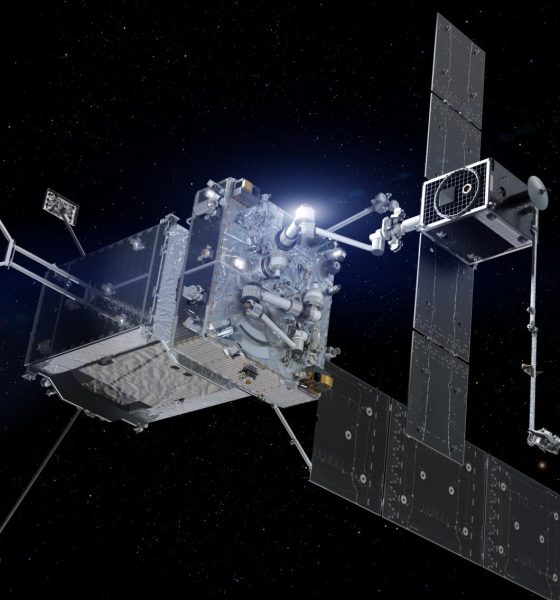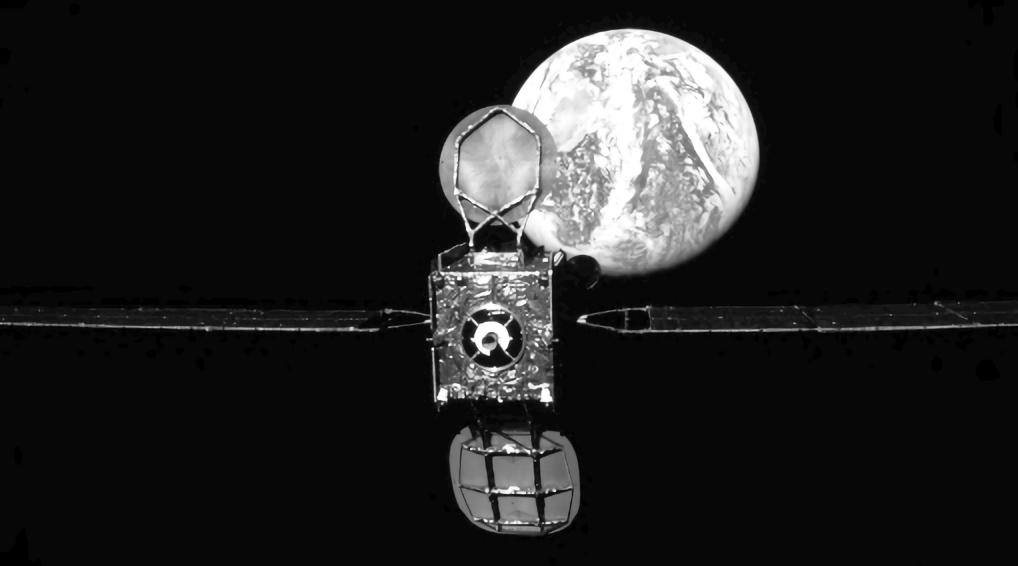

News
SpaceX to launch “next-generation satellite-servicing vehicle” for Northrop Grumman
Northrop Grumman subsidiary SpaceLogistics has selected SpaceX to launch its first Mission Robotic Vehicle (MRV) – better described as the company’s “next-generation satellite-servicing” spacecraft.
As far as SpaceX’s Falcon 9 rocket is concerned, MRV-1 is just another geostationary satellite for it to deliver to a transfer orbit around 35,800 kilometers (~22,200 mi) above Earth’s surface as early as “spring 2024.” As of now, SpaceX Falcon rockets have launched more than 35 satellites to geostationary transfer orbits (GTO) and have at least 18 more geostationary launch contracts on its manifest – 19 including MRV-1. MRV-1 is no ordinary geostationary communications satellite, however.
MRV isn’t a communications satellite at all, in fact. Instead, designed to be the second generation of Northrop Grumman’s satellite life-extension spacecraft, MRV aims to build upon the successes of the company’s first two Mission Extension Vehicles (MEVs). The first (MEV-1) became the first spacecraft in history to dock with another spacecraft in geostationary orbit (GEO) in February 2020. The second, MEV-2, successfully launched and docked with a different geostationary communications satellite in 2021. Both MEVs did exactly what they were supposed to, effectively giving their host satellites – Intelsat 10-02 and 901, both more than 15 years old – at least five more years of operational life.
While SpaceLogistics’ accomplishments are thus extremely impressive, the general MEV concept and parts of its execution have some flaws. First, the ‘service’ offered appears to be extremely expensive, costing Intelsat – the first and only customer, thus far – at least $13 million per year for the five years MEV-1 will be servicing Intelsat-901. No other MEV contracts have been confirmed, which is not a major surprise. Assuming zero upfront costs for prospective customers, $65 million for an extra five years of operations represents a substantial fraction of the price of some simpler replacement satellites, many of which are now designed to operate for at least 15 years.

Put simply, at the secretive price point SpaceLogistics is offering, MEVs are a mostly ambiguous financial proposition for the geostationary satellite communications industry, which tends to operate on razor-thin margins. Though SpaceLogistics hasn’t said as much, MRV seems to be a response to the issue of affordability. Instead of building one large, expensive MEV that can only service a single GEO satellite, MRV aims to operate more like a multipurpose space tug.
To complement MRV, Northrop Grumman is also developing Mission Extension Pods (MEPs) – smaller spacecraft designed to still add at least 5-6 years of life to an aging GEO satellite. MRVs – each about 3 tons (~7000 lb) will theoretically be able to carry several MEPs (400 kg/900 lb apiece) into geostationary orbit and install the pods on several different satellites. Additionally, it appears that SpaceLogistics will sell the pods outright, presumably precluding the need for expensive recurring service contracts like those Intelsat signed for MEV life extension.
According to Northrop Grumman, MEPs will actually propel themselves into GEO before being recaptured and installed by MRV – requiring two rendezvous and docking maneuvers per satellite instead of one. It’s entirely unclear why that added complexity is preferable over the obvious alternative, in which MRV would launch with a number of MEPs, carry them to GEO, and install them when needed.
Nonetheless, assuming Northrop Grumman plans to offer MEP life-extension pods for less than it charged for MEVs, it’s not hard to imagine the service becoming a no-brainer for communications providers with satellites that are close to running out of propellant. If the cost of several extra years of operational life is lower than the cost of an equivalent fraction of the lifespan of a new replacement satellite, it’s difficult to imagine how satellite operators could afford not to take advantage of life extension.
Northrop Grumman says it’s already sold one MEP – to launch with MRV-1 on Falcon 9 – to Australian telecom provider Optus and has a full manifest for MEPs “through mid-2026.”

Elon Musk
Elon Musk’s X will start using a Tesla-like software update strategy
The initiative seems designed to accelerate updates to the social media platform, while maintaining maximum transparency.

Elon Musk’s social media platform X will adopt a Tesla-esque approach to software updates for its algorithm.
The initiative seems designed to accelerate updates to the social media platform, while maintaining maximum transparency.
X’s updates to its updates
As per Musk in a post on X, the social media company will be making a new algorithm to determine what organic and advertising posts are recommended to users. These updates would then be repeated every four weeks.
“We will make the new 𝕏 algorithm, including all code used to determine what organic and advertising posts are recommended to users, open source in 7 days. This will be repeated every 4 weeks, with comprehensive developer notes, to help you understand what changed,” Musk wrote in his post.
The initiative somewhat mirrors Tesla’s over-the-air update model, where vehicle software is regularly refined and pushed to users with detailed release notes. This should allow users to better understand the details of X’s every update and foster a healthy feedback loop for the social media platform.
xAI and X
X, formerly Twitter, has been acquired by Elon Musk’s artificial intelligence startup, xAI last year. Since then, xAI has seen a rapid rise in valuation. Following the company’s the company’s upsized $20 billion Series E funding round, estimates now suggest that xAI is worth tens about $230 to $235 billion. That’s several times larger than Tesla when Elon Musk received his controversial 2018 CEO Performance Award.
As per xAI, the Series E funding round attracted a diverse group of investors, including Valor Equity Partners, Stepstone Group, Fidelity Management & Research Company, Qatar Investment Authority, MGX, and Baron Capital Group, among others. Strategic partners NVIDIA and Cisco Investments also continued support for building the world’s largest GPU clusters.
News
Tesla FSD Supervised wins MotorTrend’s Best Driver Assistance Award
The decision marks a notable reversal for the publication from prior years, with judges citing major real-world improvements that pushed Tesla’s latest FSD software ahead of every competing ADAS system.

Tesla’s Full Self-Driving (Supervised) system has been named the best driver-assistance technology on the market, earning top honors at the 2026 MotorTrend Best Tech Awards.
The decision marks a notable reversal for the publication from prior years, with judges citing major real-world improvements that pushed Tesla’s latest FSD software ahead of every competing ADAS system. And it wasn’t even close.
MotorTrend reverses course
MotorTrend awarded Tesla FSD (Supervised) its 2026 Best Tech Driver Assistance title after extensive testing of the latest v14 software. The publication acknowledged that it had previously criticized earlier versions of FSD for erratic behavior and near-miss incidents, ultimately favoring rivals such as GM’s Super Cruise in earlier evaluations.
According to MotorTrend, the newest iteration of FSD resolved many of those shortcomings. Testers said v14 showed far smoother behavior in complex urban scenarios, including unprotected left turns, traffic circles, emergency vehicles, and dense city streets. While the system still requires constant driver supervision, judges concluded that no other advanced driver-assistance system currently matches its breadth of capability.
Unlike rival systems that rely on combinations of cameras, radar, lidar, and mapped highways, Tesla’s FSD operates using a camera-only approach and is capable of driving on city streets, rural roads, and freeways. MotorTrend stated that pure utility, the ability to handle nearly all road types, ultimately separated FSD from competitors like Ford BlueCruise, GM Super Cruise, and BMW’s Highway Assistant.
High cost and high capability
MotorTrend also addressed FSD’s pricing, which remains significantly higher than rival systems. Tesla currently charges $8,000 for a one-time purchase or $99 per month for a subscription, compared with far lower upfront and subscription costs from other automakers. The publication noted that the premium is justified given FSD’s unmatched scope and continuous software evolution.
Safety remained a central focus of the evaluation. While testers reported collision-free operation over thousands of miles, they noted ongoing concerns around FSD’s configurable driving modes, including options that allow aggressive driving and speeds beyond posted limits. MotorTrend emphasized that, like all Level 2 systems, FSD still depends on a fully attentive human driver at all times.
Despite those caveats, the publication concluded that Tesla’s rapid software progress fundamentally reshaped the competitive landscape. For drivers seeking the most capable hands-on driver-assistance system available today, MotorTrend concluded Tesla FSD (Supervised) now stands alone at the top.
News
Elon Musk’s Grokipedia surges to 5.6M articles, almost 79% of English Wikipedia
The explosive growth marks a major milestone for the AI-powered online encyclopedia, which was launched by Elon Musk’s xAI just months ago.

Elon Musk’s Grokipedia has grown to an impressive 5,615,201 articles as of today, closing in on 79% of the English Wikipedia’s current total of 7,119,376 articles.
The explosive growth marks a major milestone for the AI-powered online encyclopedia, which was launched by Elon Musk’s xAI just months ago. Needless to say, it would only be a matter of time before Grokipedia exceeds English Wikipedia in sheer volume.
Grokipedia’s rapid growth
xAI’s vision for Grokipedia emphasizes neutrality, while Grok’s reasoning capabilities allow for fast drafting and fact-checking. When Elon Musk announced the initiative in late September 2025, he noted that Grokipedia would be an improvement to Wikipedia because it would be designed to avoid bias.
At the time, Musk noted that Grokipedia “is a necessary step towards the xAI goal of understanding the Universe.”
Grokipedia was launched in late October, and while xAI was careful to list it only as Version 0.1 at the time, the online encyclopedia immediately earned praise. Wikipedia co-founder Larry Sanger highlighted the project’s innovative approach, noting how it leverages AI to fill knowledge gaps and enable rapid updates. Netizens also observed how Grokipedia tends to present articles in a more objective manner compared to Wikipedia, which is edited by humans.
Elon Musk’s ambitious plans
With 5,615,201 total articles, Grokipedia has now grown to almost 79% of English Wikipedia’s article base. This is incredibly quick, though Grokipedia remains text-only for now. xAI, for its part, has now updated the online encyclopedia’s iteration to v0.2.
Elon Musk has shared bold ideas for Grokipedia, including sending a record of the entire knowledge base to space as part of xAI’s mission to preserve and expand human understanding. At some point, Musk stated that Grokipedia will be renamed to Encyclopedia Galactica, and it will be sent to the cosmos.
“When Grokipedia is good enough (long way to go), we will change the name to Encyclopedia Galactica. It will be an open source distillation of all knowledge, including audio, images and video. Join xAI to help build the sci-fi version of the Library of Alexandria!” Musk wrote, adding in a later post that “Copies will be etched in stone and sent to the Moon, Mars and beyond. This time, it will not be lost.”








